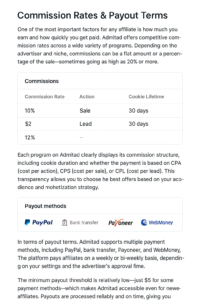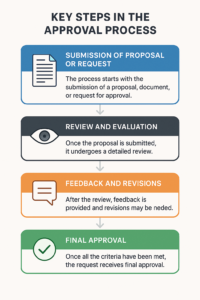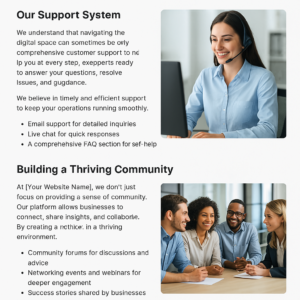Admitad Review
admited introduction
Admitad is a global affiliate marketing network that connects advertisers with publishers to drive traffic, leads, and sales. It provides tools and services for performance marketing, including affiliate programs, tracking solutions, and data analytics. With a wide range of partners and verticals—like e-commerce, finance, travel, and apps—Admitad helps businesses grow by leveraging a results-driven, commission-based model.
Ease of Use & Interface
When it comes to affiliate marketing platforms, a clean and intuitive interface makes a big difference—especially for beginners. Admitad offers a user-friendly dashboard that’s easy to navigate, even if you’re new to affiliate marketing. From signing up to tracking your earnings, every feature is laid out in a logical way.
Once you log into Admitad, the main dashboard gives you a quick overview of your performance metrics, recent activity, and available campaigns. The navigation menu is straightforward, with clear sections like “Programs,” “Reports,” “Tools,” and “Payments.” This reduces the learning curve and helps you find what you need without wasting time.
One standout feature is the smart search and filtering system when browsing affiliate programs. You can quickly sort offers by category, country, commission type, and other filters—making it much easier to find programs that match your niche.
Even with all its features, Admitad keeps the design clean and avoids clutter, which improves user experience. Whether you’re checking your stats or setting up deep links, the platform makes each task simple and efficient. click here
Variety and Quality of Affiliate Programs
One of the key strengths of Admitad is the wide range of affiliate programs it offers. Whether you’re in eCommerce, travel, finance, education, or digital services, you’ll find campaigns that match your niche. The platform hosts thousands of affiliate programs from both global brands and regional businesses, giving affiliates plenty of choices.
Admitad partners with well-known companies like AliExpress, Booking.com, and Lenovo, which boosts credibility and ensures that the offers are high quality. You’ll also find smaller, niche-specific programs that can be highly profitable if you have a focused audience.
What makes Admitad stand out is how easy it is to explore and join these programs. Each offer includes detailed information like commission structure, approval type (auto or manual), and traffic rules. This transparency helps affiliates make informed decisions before promoting any brand.
Additionally, the quality control is solid. Programs listed on Admitad go through a vetting process to ensure advertisers are trustworthy and pay commissions on time. This adds a layer of confidence for affiliates looking to build long-term partnerships.
Commission Rates & Payout Terms
One of the most important factors for any affiliate is how much you earn and how quickly you get paid. Admitad offers competitive commission rates across a wide variety of programs. Depending on the advertiser and niche, commissions can be a flat amount or a percentage of the sale—sometimes going as high as 20% or more.
Each program on Admitad clearly displays its commission structure, including cookie duration and whether the payment is based on CPA (cost per action), CPS (cost per sale), or CPL (cost per lead). This transparency allows you to choose the best offers based on your audience and monetization strategy.
In terms of payout terms, Admitad supports multiple payment methods, including PayPal, bank transfer, Payoneer, and WebMoney. The platform pays affiliates on a weekly or bi-weekly basis, depending on your settings and the advertiser’s approval time.
The minimum payout threshold is relatively low—just $5 for some payment methods—which makes Admitad accessible even for new affiliates. Payouts are processed reliably and on time, giving you peace of mind as you scale your affiliate business.
Tracking & Reporting Tools
Accurate tracking and detailed reporting are essential for success in affiliate marketing. Admitad offers a robust set of tools that make it easy to monitor your performance in real time.
The platform provides in-depth analytics that cover clicks, conversions, earnings, approval rates, and more. You can customize reports by time period, program, or geography to better understand what’s working and where to improve. All data is updated in real time, so you’re always looking at the most current information.
One of the standout tools on Admitad is its SubID tracking system. This allows you to tag and track traffic sources—so you can see exactly which campaigns, content, or platforms are driving conversions. It’s especially useful if you use multiple channels like blogs, email, and social media.
Additionally, the postback and pixel tracking options are a big plus for advanced users who want to integrate tracking with third-party analytics platforms. These features ensure you have full control and transparency over your performance data.

Approval Process & Accessibility
The approval process is a crucial aspect of any project, ensuring that all necessary steps are taken before a decision or action is finalized. It serves as a structured method to review, validate, and confirm the required elements. This process can involve multiple stakeholders, feedback loops, and sometimes revisions before final approval is granted.
When considering accessibility within the approval process, it’s important to ensure that the process itself is accessible to everyone, including individuals with disabilities. Accessibility goes beyond just the product or service; it should encompass every phase, from the initial approval request to the final outcome. Ensuring accessibility in the approval process can help avoid discrimination, foster inclusion, and support equal opportunities for all involved.
Key Steps in the Approval Process
-
Submission of Proposal or Request: The process starts with the submission of a proposal, document, or request for approval. This document should be clear, concise, and accessible to all parties involved.
-
Review and Evaluation: Once the proposal is submitted, it undergoes a detailed review. It is assessed for quality, accuracy, and alignment with the project’s objectives. During this phase, accessibility features—such as readability, use of assistive technologies, or alternative formats—should be considered.
-
Feedback and Revisions: After the review, feedback is provided. Revisions may be needed to meet certain requirements, and it is essential that the feedback is delivered in an accessible manner, ensuring all stakeholders can understand and act on it.
-
Final Approval: The final step is the approval of the document or request. Once all the criteria have been met, and accessibility is confirmed, the process concludes with formal approval.
Accessibility Considerations in the Approval Process
-
Document Accessibility: Ensure that all documents involved in the approval process are accessible to individuals with disabilities. This includes making documents compatible with screen readers, providing text descriptions for images, and using accessible fonts and colors.
-
Communication Accessibility: The feedback and communication between stakeholders should be accessible. This may include offering multiple communication methods (e.g., email, phone, video calls) and ensuring that meetings or reviews are conducted in a way that accommodates all participants.
-
Digital Accessibility: If the approval process is carried out digitally, ensure that the platform or software used complies with web accessibility standards (WCAG). This includes ensuring the site is navigable with a keyboard, screen reader-compatible, and provides alternative text for media.
Benefits of an Accessible Approval Process
-
Inclusivity: An accessible approval process ensures that all participants, regardless of ability, can engage in decision-making and feedback loops.
-
Efficiency: By making the process accessible, you reduce delays caused by misunderstandings or obstacles, leading to faster approvals and smoother workflows.
-
Compliance: For many organizations, ensuring accessibility is not just best practice—it is a legal requirement. Complying with accessibility standards helps avoid legal and reputational risks.
Conclusion
The approval process should not only focus on evaluating the content of a proposal but also on ensuring that every step of the process is accessible to all participants. Making the approval process accessible ensures efficiency, inclusivity, and compliance while promoting a positive and equitable work environment.
Support & Community
At kadarguide, we believe in the power of support and community to drive success. Whether you’re a business looking to advertise your products or a customer seeking advice, we are committed to providing exceptional assistance and building a strong community around our platform.
Our Support System
We understand that navigating the digital space can sometimes be overwhelming. That’s why we offer comprehensive customer support to help you at every step. Our team of experts is always ready to answer your questions, resolve issues, and provide guidance to ensure your experience is seamless.
You can reach out to us via:
-
Email support for detailed inquiries
-
Live chat for quick responses
-
A comprehensive FAQ section for self-help
We believe in timely and efficient support to keep your operations running smoothly.
Building a Thriving Community
At [Your Website Name], we don’t just focus on providing services — we foster a sense of community. Our platform allows businesses to connect, share insights, and collaborate. By creating a network of businesses that support each other, we help you grow in a thriving environment.
We also offer resources such as:
-
Community forums for discussions and advice
-
Networking events and webinars for deeper engagement
-
Success stories shared by businesses like yours
Joining our community means having access to a wealth of knowledge and a network of professionals who are dedicated to helping each other succeed.
Get Involved
We encourage you to be an active part of our support and community initiatives. Engage with other businesses, participate in discussions, and share your experiences. The more you contribute, the more you’ll benefit from the insights and connections that come from being a part of our vibrant community.
If you need help or want to get involved, don’t hesitate to reach out. We’re here to ensure that you have all the support you need to succeed.
Payment Options & Reliability
Payment Options & Reliability: A Guide to Seamless Transactions
When it comes to managing transactions, providing diverse payment options and ensuring their reliability are critical for both businesses and customers. In today’s digital age, customers expect flexibility, security, and ease when paying for products or services. Offering various payment methods can boost your business’s credibility, improve the customer experience, and potentially increase sales.
1. Understanding the Importance of Payment Options
Providing multiple payment options gives customers the freedom to choose the method that suits them best. Whether it’s credit cards, debit cards, mobile wallets like Apple Pay or Google Wallet, or even direct bank transfers, accommodating various preferences is key to attracting a wider audience.
For businesses, offering flexible payment options also helps reduce cart abandonment, as customers are more likely to complete their purchase if their preferred method is available.
2. Security and Reliability in Payment Processing
While offering diverse payment options is essential, the reliability of your payment processing system is equally crucial. Customers need to trust that their payment information is safe and that their transactions will be processed without error.
This is where secure payment gateways come into play. Look for payment processors that comply with industry standards like PCI-DSS (Payment Card Industry Data Security Standard). Additionally, using SSL (Secure Sockets Layer) encryption ensures that sensitive information is transmitted securely, building trust with customers.
3. Customer Support for Payment-Related Issues
Even with the most reliable systems in place, payment-related issues can arise. Whether it’s a technical glitch, a misunderstanding about charges, or a failed transaction, having a responsive customer support system in place is crucial for maintaining trust.
Make sure that your business offers timely and helpful support through various channels—phone, email, and live chat. A clear and straightforward return/refund policy is also essential for addressing payment concerns efficiently.
4. Global Payment Options
As businesses expand globally, it’s essential to cater to international customers by offering payment options that are commonly used in different regions. Whether it’s PayPal, local bank transfers, or even cryptocurrency, accommodating a global audience can significantly enhance your business’s reach and reliability.
5. Ensuring a Seamless Payment Experience
A seamless payment experience is about more than just offering multiple payment options. It’s about making sure that the payment process is quick, easy to understand, and user-friendly. The fewer steps required to complete a transaction, the higher the chances of a successful purchase.
This also means mobile optimization, as many users now shop directly from their smartphones. Ensuring that your payment system works flawlessly across devices will improve customer satisfaction.
Conclusion
In conclusion, offering a variety of payment options and ensuring reliability are essential for building trust with your customers and enhancing their overall experience. By prioritizing security, providing excellent customer support, and catering to a global market, your business can stand out as a reliable and convenient choice for consumers.





